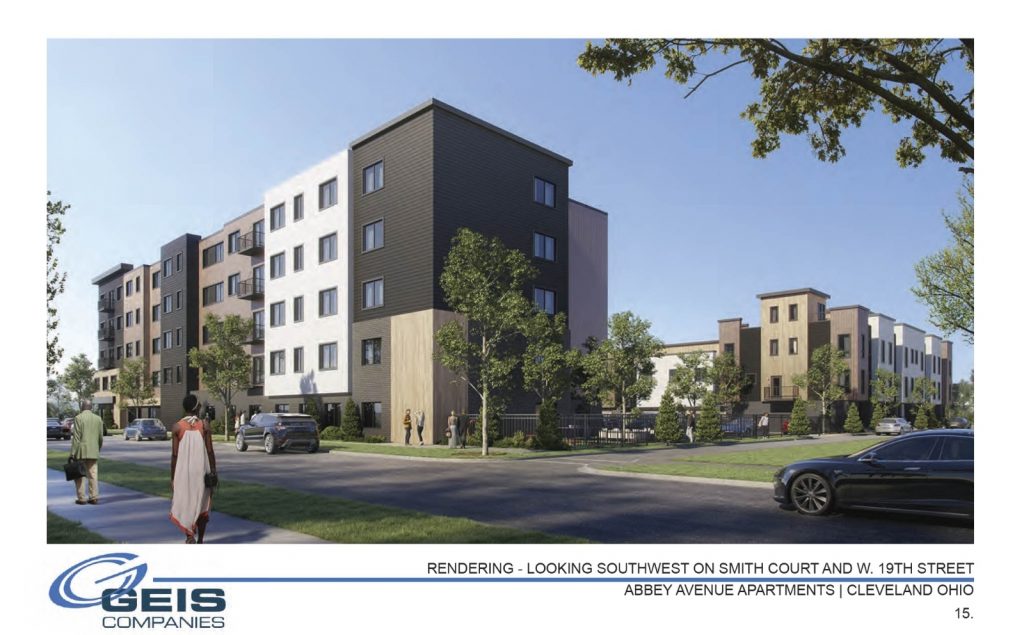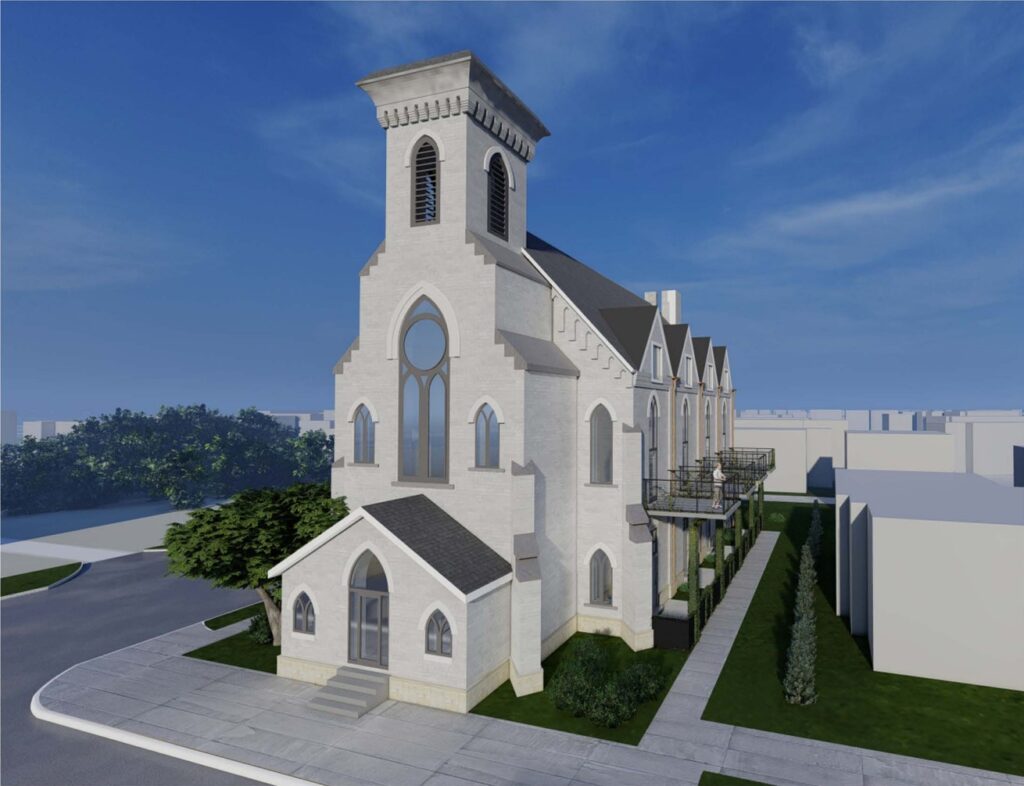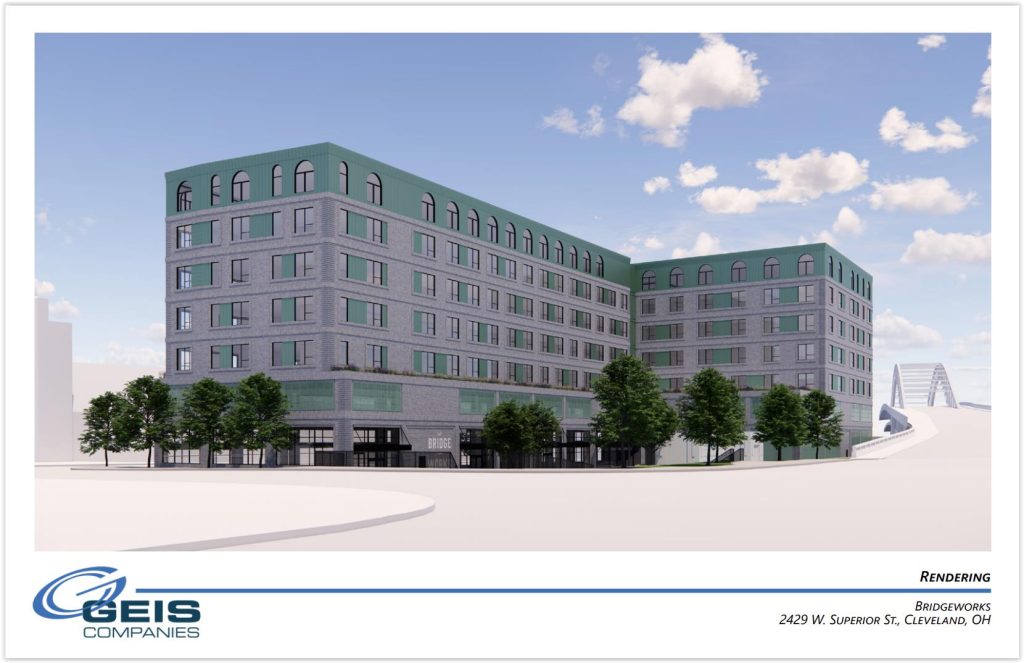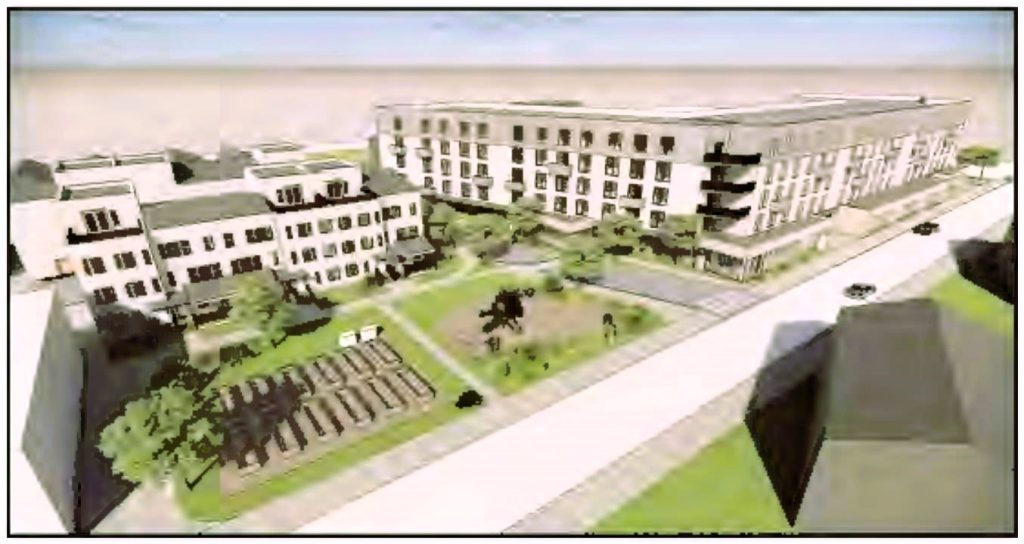
An updated but low-resolution rendering that was submitted to the Ohio Housing Financing Agency shows the evolution of the Watterson-Lake redevelopment project. It includes some design refinements like bigger corner balconies, civic gardens and more detail for the proposed townhomes at left. In this northwest-looking view, West 74th Street is in the foreground and Detroit Avenue is on the other side of the proposed large building (Stantec). CLICK IMAGES TO ENLARGE THEM.
Site to be co-developed, managed by CMHA
More details are emerging for the proposed Watterson-Lake redevelopment in Cleveland’s Detroit-Shoreway neighborhood including the project’s growing size, parking situation, how it will be funded and who will manage the property. According to a project funding application posted earlier this month by the Ohio Housing Finance Agency (OHFA), the answer to the last question is the Cuyahoga Metropolitan Housing Authority (CMHA).
The $50.8 million, 202,633-square-foot mixed-use development, sought by Bridging The Gap LLC of Pittsburgh, will now offer 136 apartments with 124 in a five-story, multifamily building set back from Detroit Avenue. Another dozen units will be rental townhomes, facing West 75th Street. At last report, 80 parking spaces are planned to be included on the multifamily building’s ground floor plus two garage parking spaces in each townhome.
As recently as November 2023, the development was proposed with 112 apartments in the building near Detroit and the 12 rental townhomes. Plus there will be retail and small business incubator spaces on Detroit at West 74th Street, as well as community, park and gardens spaces along West 74th, plans showed.
“The project will include a large community service facility requested by the neighborhood as part of an RFP (request for proposals) process,” Bridging The Gap said in its OHFA application. “The city will continue to own the real estate, providing a no-cost lease to the developers, as well as significant soft funding.”
In its financing application, Bridging The Gap also listed its project team members, noting that the property will be managed by CMHA. And some apartments could accept housing vouchers, made possible by a joint development agreement with CMHA, said Derrick Tillman, chief executive officer of Bridging The Gap. The co-developer is Western Reserve Revitalization and Management Company, Inc., CMHA’s nonprofit development arm.
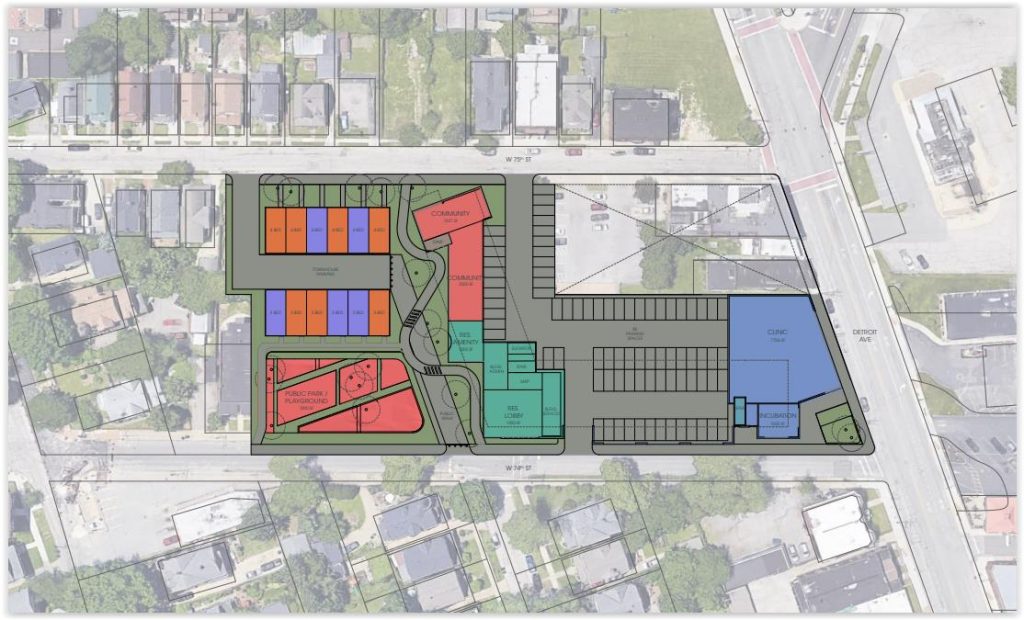
With Detroit Avenue to the north or right side of this ground-level site plan, the retail and incubator spaces (blue) proposed to front the property. Eighty enclosed parking spaces are planned with the apartment building’s lobby and amenity spaces shown in green. Indoor and outdoor community spaces are shown in red on either side of a pedestrian street aligned as an extension of Clinton Avenue. Three- and four-bedroom townhomes are displayed in orange and purple (Stantec).
The land is currently owned by the Cleveland Metropolitan School District as it recently hosted the Watterson-Lake Elementary School, demolished last year. Thus, a property transfer with the city is in order. Ward 15 Councilwoman Jenny Spencer and the developer said they want more affordable housing as an expanding area of revitalization is making the Detroit-Shoreway unaffordable for many.
“The city has a 10-year housing study that shows this massive deficit of affordable housing,” Spencer said at a public meeting she hosted in November to gather input in the Watterson-Lake redevelopment.
“Located just a few blocks west of the Gordon Square Arts District, Waterson-Lake will provide much-needed affordable housing at a range of rents and unit types in a gentrifying neighborhood,” Bridging The Gap added in its OHFA application.
It is seeking from OHFA $25 million over 10 years in 4 percent Low Income Housing Tax Credits (LIHTC). Four percent tax credits are noncompetitive — in other words, if someone applies for these credits, they almost always get them.
All apartments will be priced as affordable, meaning they will have rents that are affordable to people earning 80 percent or less of the area’s median household income (AMI). Greater Cleveland’s AMI in 2023, according to the Department of Housing and Urban Affairs, was $31,650 for a one-person household or $36,200 for two people.
Average monthly rent is projected at $1,097.58 or about $1 per square foot, the OHFA data shows. That is anywhere from one-half to one-third of the rents that are being charged for housing farther east in the Gordon Square area and northward closer to Edgewater Park and Lake Erie, Spencer noted.
Thirty of the apartments will be subsidized to offer rents well below the average of $1 per square foot, allowing them to be afforded by people earning 30 percent of the AMI. Of those, 11 will be studios, another 11 will be one-bedroom apartments and eight will be two-bedroom apartments. The remaining apartments will be affordable to 50-80 percent of AMI, according to the OHFA application.
In the multifamily building, there will be 48 studios, 48 one-bedroom apartments, and 28 two-bedroom suites, Bridging The Gap says in its financing application. Plans show the 12 townhomes will offer seven three-bedroom homes and five four-bedroom homes, each to be rented at 80 percent AMI.
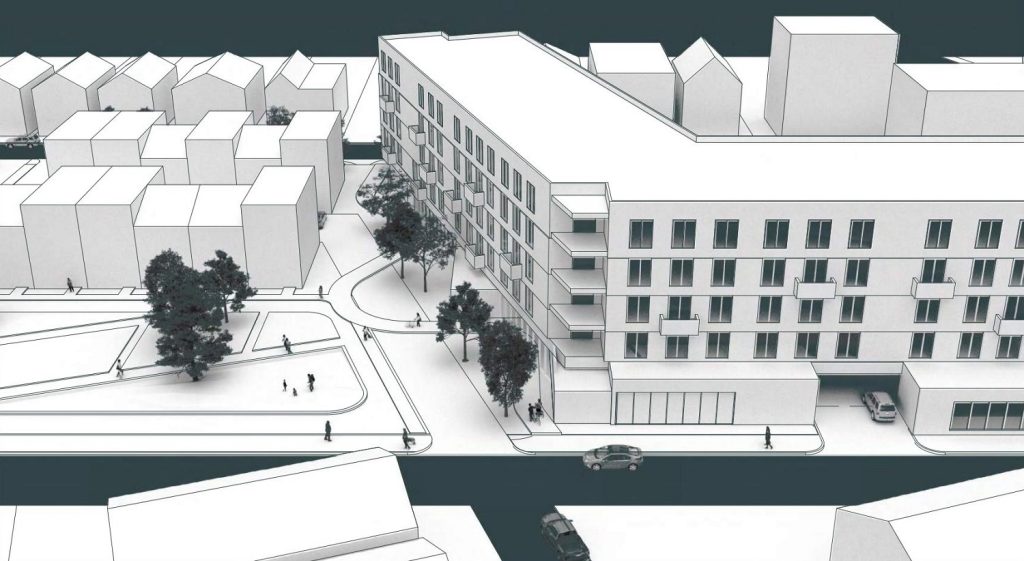
This westward view at the Watterson-Lake development from West 74th Street shows how Clinton Avenue is proposed to be extended into the development site as a pedestrian-oriented street. A public park with a playground is shown at the left with 12 townhomes just beyond. An entrance to the 80-space parking garage below the apartment building is visible at right (Stantec).
Commercial and fee-driven spaces, such as for retail and incubator areas, are proposed to measure 26,219 square feet total and will be divisible. There will be 27,847 square feet of common areas and 2,387 square feet for support and program space such as a management office, wellness/health clinic or a day care center, Bridging The Gap’s application says.
“Our mission is to simply bridge gaps of opportunity and also to bridge gaps in development,” Tillman said at the November public hearing. “When we say bridging gaps of opportunity, (we) really focus on creating opportunities for minorities, for women as well as the local residents in the community that we’re serving. In bridging gaps in development, which is focused on bringing catalytic, transformative development projects like this to different communities, both communities that are thriving and communities that are also in transition.”
Most of the construction funding is coming from a $20 million Huntington Bank loan, with another $10.4 million from an as-yet-unidentified construction loan, $4,285,000 from the city of Cleveland’s Housing Trust Fund, $2.8 million from state and federal low income housing tax credit equity, plus $1 million from two city Urban Development Action Grants. Another $11.8 million in costs will not be incurred until construction is completed, including most of an $8 million developer fee, the application shows.
Other development team members include project consultant Lowenstein Development, LLC of Columbus, OH and LIHTC syndicator/investor Enterprise Community Investment of Columbus, MD. The general construction contractor is Next Generation Construction while the architect is Stantec Architecture, Inc., both of Cleveland.
END


